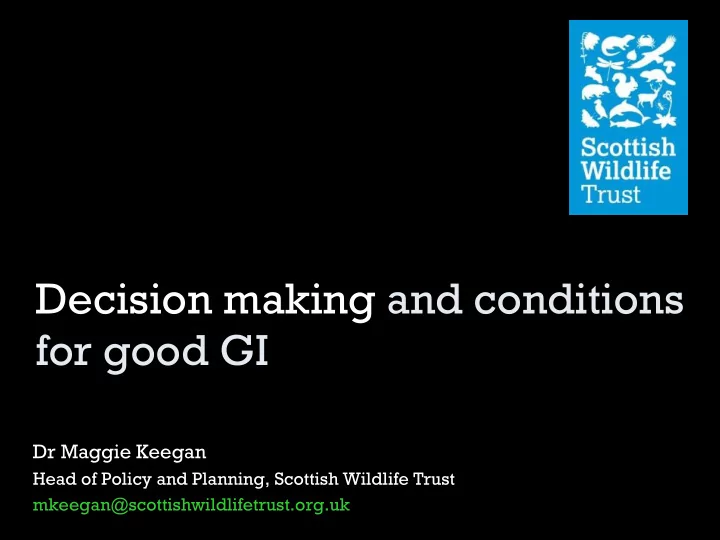

Decision making and conditions for good GI Dr Maggie Keegan Head of Policy and Planning, Scottish Wildlife Trust mkeegan@scottishwildlifetrust.org.uk
Natural Capital Standard for Green Infrastructure Dr Maggie Keegan Head of Policy and Planning, Scottish Wildlife Trust mkeegan@scottishwildlifetrust.org.uk
How do we achieve consistently good GI design in development?
Natural capital standard for green infrastructure - an evaluation tool to assesses the quality and quantity of GI in development
An evaluation tool GI factor = Total area of green and blue infrastructure Total development surface area
Context Bo01
An evaluation tool GI factor = Total area of green and blue infrastructure Total development surface area
An evaluation tool GI factor = ∑ ((Area a x weighting factor) + (Area b x weighting factor) + etc) Total surface area of development footprint
Weighting factor depends on ecosystem services
Ecosystem services • Carbon sequestration • Aesthetics • Pollination • Water quality • Air quality • Slowing water movement • Biodiversity • Soil quality regulation • Local climate regulation
Weighting factor - ecosystem services Sealed surface = 0 Permeable paving = 0.2 Green roof (HBV) = 0.6 Amenity grassland = 0.3 Naturalised grassland = 0.6 Shrub bed LBV = 0.4 Vertical greening HBV = 0.4 SUDS HBV= 0.8 SUDS LBV = 0.3 Planted native tree or shrub = 0.4 Stand of 10+ trees (retained ) = 1 Retained native hedgerow = 1 Planted native hedgerow = 0.4 Community growing area/allotment = 0.6
GI weighting factor Planted n. tree = 0.4 Shrub bed HBV = 0.8 Naturalised grassland = 0.6 SUDS Permeable paving HBV = 0.8 = 0.2
Surface Weighting (W) Stand of 10+ trees / woodland retained HBV 1 Retained native hedgerow (≥ 3 native species) 1 Retained native hedgerow (≤ 2 species) 0.8 Stand of 10+ trees / woodland retained LBV 0.8 Retained species rich meadow 0.8 Retained non-native hedgerow 0.8 Retained native tree 0.8 SuDS HBV 0.8 Community growing area/allotment 0.8 Rain garden HBV 0.8 Retained non-native tree 0.8 Shrub bed HBV 0.8 Stand of 10+ trees / woodland planted HBV 0.8 Green roof HBV 0.8 Established wildflower meadow 0.8 Vertical greening HBV 0.6 Stand of 10+ trees / woodland planted LBV 0.6 Water feature (e.g. pond) - naturalised, HBV 0.6 Amenity grassland with bulbs / naturalised grassland (e 0.6 Shrub bed LBV 0.4 SuDS LBV 0.4 Amenity grassland 0.4 Green roof LBV 0.4 Rain garden LBV 0.4 Planted native tree 0.4 Planted native hedgerow ( ≥ 3 native species) 0.4 Planted native hedgerow (≤ 2 species) 0.3 Vertical greening LBV+ high maintenance 0.3 Planted non-native hedgerow 0.3 Planted non-native tree 0.3 Naturalised play area 0.3 Permeable paving/gravel/ with green element 0.2 Herbaceous flower bed border 0.2 Permeable paving / gravel / partially porous surface 0.2 Water feature LBV 0.2 Sealed areas e.g. tarmac, concrete surfaces 0
Low score High score
Examples of GI ratio in development Berlin • New development = 0.6 • Commercial = 0.3 • Public facilities = 0.6 • Nursery school and daycare centre = 0.6 • Secondary school = 0.3
Context
Applications • Quality assurance • Improving GI and biodiversity in new build housing, schools, university grounds, retail and business parks • Baseline vs development analysis • Retrofitting • Climate change adaptation analysis (e.g. surface water movement, urban heat island) • Analysing ecosystem service value of existing places • Improving air quality
A worked example
GI ratio = 0.26
Thank you mkeegan@scottishwildlifetrust.org.uk
Recommend
More recommend